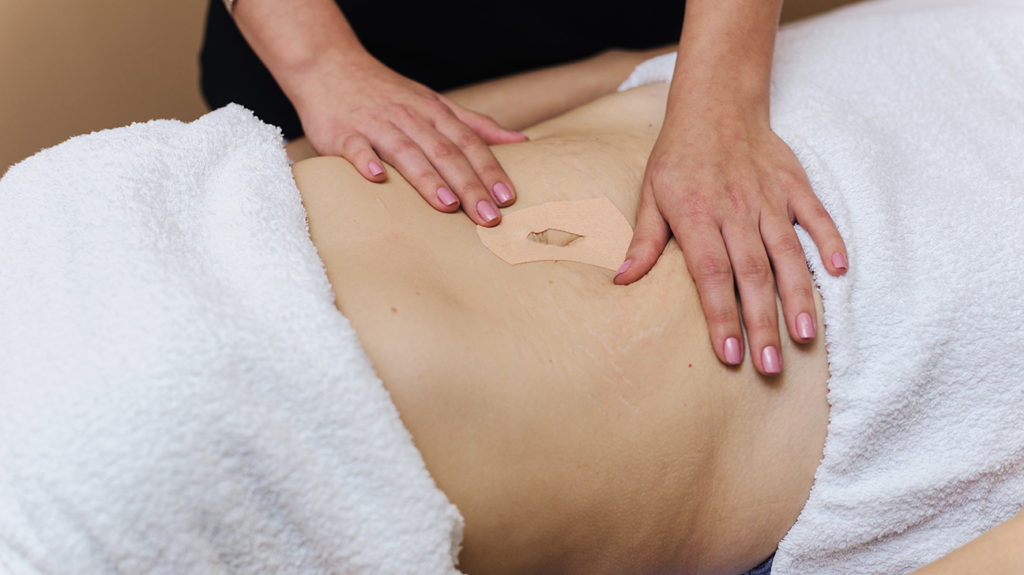Weight loss patches are a new trend in the diet industry. The manufacturers claim that the ingredients in these patches help people lose weight. People apply the patches to their skin over the areas where they want to lose weight.
Researchers have not studied the efficacy and safety of weight loss patches. However, limited evidence exists to confirm the effectiveness of some of the ingredients when people take them orally.
In this article, we look at whether weight loss patches can work. We also provide examples of some of the products available on the market.

Weight loss patches contain different ingredients that manufacturers claim can assist people in losing weight. Some of the ingredients in weight loss patches may include:
- green coffee bean extract
- Hokuto mint, which is also called Japanese mint
- acai berry
- green tea
- ephedra
- bitter orange
- flaxseed oil
Some weight loss patches combine several ingredients that may help people lose weight.
The patches supposedly work by releasing active ingredients from an embedded delivery system onto the skin’s surface. Then, the skin must absorb the particles of the active ingredient to allow them to enter the person’s bloodstream.
Nicotine patches are an example of medicine delivery via a patch.
An article in the British Journal of Pharmacology explains how manufacturers of transdermal patches face several challenges when developing their products.
The authors point out that active and nonmedicinal ingredients must incorporate into the appropriate delivery system, which must release the active ingredients from the patch onto the skin.
The ingredients must also be small enough to pass through the skin barrier. If they can do this and enter the bloodstream, the manufacturers must determine whether the amount in the bloodstream is safe and effective for its intended purpose.
Not all areas of the skin offer the same absorption rates, as the characteristics of the skin’s surface affect its ability to absorb. Humidity and heat are additional factors that can affect the absorption across the skin.
One of the benefits of using a patch is avoiding the need for the medicine to pass through the digestive tract. If the digestive system metabolizes an ingredient before the blood absorbs it, it may lose its effectiveness.
Researchers have not studied the effects of weight loss patches, and the Food and Drug Administration (FDA) do not regulate their manufacture. Insufficient information about these patches is available to understand whether the ingredients in the patch will influence weight loss.
The FDA have not approved the use of weight loss patches because no evidence is currently available on their effectiveness and safety.
As the FDA do not control these products, they do not regulate the quantity of the active ingredients in each patch or the quality of the ingredients.
Researchers have studied the effects of oral doses of some of the ingredients in weight loss patches. However, it is not possible to claim that ingredients will have the same results in the form of a patch as they do when a person ingests them.
Although manufacturers claim that using weight loss products on the skin is safer than taking oral doses, evidence on the safety of weight loss patches is lacking. It is unknown whether any weight loss patch is better than another or better than weight loss pills. Further research in humans is still necessary to answer these questions.
However, people who wish to try using weight loss patches can consider the following products:
1. Acai berry patch with green tea
Currently, no evidence suggests that acai berries help with weight loss.
Researchers have studied the effects of both green tea and green tea extract on weight loss. Drinking green tea supposedly increases the body’s metabolic rate, breaks down fat cells, and decreases the amount of fat that the body produces.
There is evidence to suggest that green tea may promote small, clinically insignificant weight loss in people with overweight. However, not all studies show weight loss. It is unknown whether these effects occur when people apply green tea patches to the skin.
Green tea extract may be unsafe. It can cause constipation, nausea, and increased blood pressure.
2. SlimKick Weight Loss Patch
The SlimKick patch contains Fucus vesiculosus. Manufacturers sometimes add this seaweed extract to weight loss products. Fucus vesiculosus contains iodine, which may have an association with diabetes, but no evidence on weight loss in humans exists. It may be safe when a person applies it to the skin.
Zinc pyruvate is another popular weight loss ingredient in the SlimKick patch. Supplement manufacturers claim that zinc pyruvate increases fat breakdown and reduces body weight. Although this ingredient is safe at oral doses of 30 grams per day for up to 6 weeks, researchers cannot confirm its effectiveness in patches.
3. Himitsu Patch
The Himitsu patch contains Japanese mint. The developers of this patch report that Japanese mint helps break down fat cells, boost metabolism, and block the absorption of sugar and starch. Studies on the benefits and risks of Japanese mint on weight loss are lacking, though.
4. Zycie Nutrition Slimming Patch
This patch contains several ingredients that some claim can help people lose weight, such as Fucus vesiculosus and zinc pyruvate. As we previously mentioned, though, these ingredients may not be as effective as manufacturers claim.
The patch also contains bitter orange extract, which may reduce a person’s appetite and help their body burn more calories and break down fat more easily. However, the evidence behind these claims is lacking.
Some people report side effects when using bitter orange, including:
- chest pain
- anxiety
- headaches
- muscle and bone pain
- rapid heartbeat
- high blood pressure
Although some people may have lost weight while using weight loss patches, researchers have not rigorously studied their effects in clinical trials. People should not rely on weight loss patches to lose weight.
Many other weight loss products and patches are available on the market, but people should speak with a doctor before using any product to help them lose weight. Doctors can recommend methods for losing weight that clinical trials have demonstrated to be effective and safe.
Weight loss patches are not a reliable way to lose weight. The most effective way to lose weight is by making lifestyle changes. These can help people reach realistic weight loss goals in small incremental steps.
If a person is likely to experience health benefits by losing weight, a doctor may recommend that they aim to reduce their starting weight by 10%. For example, a person with a weight of 200 pounds (lb) could try to lose 20 lb.
A safe and sustainable rate of weight loss is about 1–2 lb per week. Once the person reaches their initial goal, they may continue to try to lose weight, if they wish to or a doctor advises it.
Doctors recommend following a low calorie diet to aid weight loss. The number of calories that a person should consume every day depends on several factors, including their baseline weight, gender, age, and activity level. A doctor or nutritionist can help a person calculate the best total daily calorie intake and macronutrient breakdown for them.
Combining a low calorie diet with an exercise regimen can promote weight loss that may result in lower abdominal fat, which is a determinant of cardiovascular health.
These measures are not easy to implement every day, and some people may find behavioral therapy useful as they adjust to lifestyle changes. Having a strong and consistent support system may also help people who are trying to lose weight or maintain their weight loss.
Researchers have not yet studied the efficacy and safety of weight loss patches.
Although some of the ingredients may have weight loss benefits when people take them orally, researchers need to continue studying them to confirm whether they work in a patch.
As the FDA do not regulate weight loss patches, people should speak with a doctor before using any of these products.
Doctors generally recommend lifestyle and dietary changes for weight loss.


